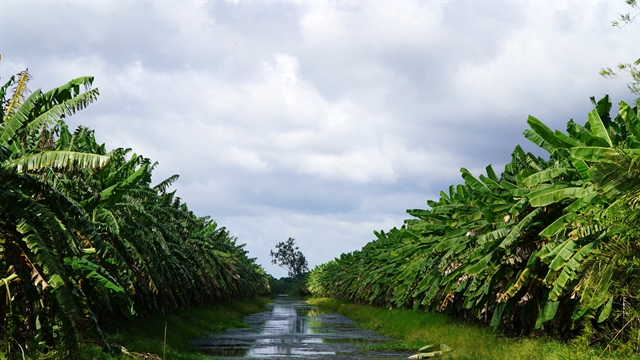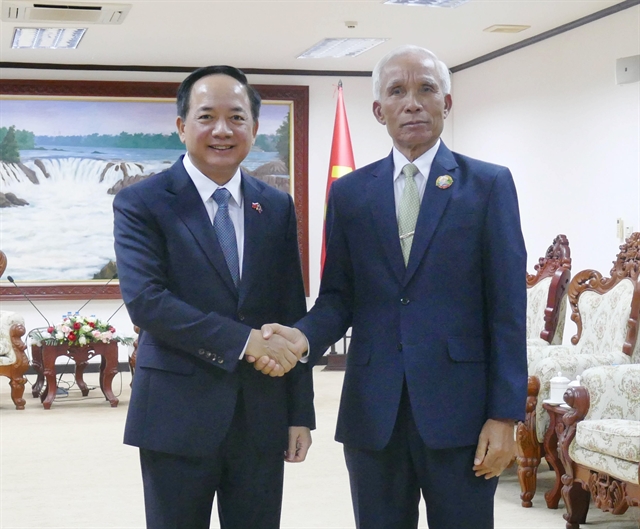 Society
Society
.jpg)
 |
| A banana farm in U Minh Thượng District’s An Minh Bắc Commune, which is Kiên Giang Province’s largest banana growing area. – VNA/VNS Photo Văn Sĩ |
KIÊN GIANG – The zoning of production areas in association with the development of climate-adaptive farming models in Kiên Giang Province (part of An Giang Province as of June 16) has improved farmers’ incomes.
Kiên Giang is one of the coastal localities in the Cửu Long (Mekong) Delta that has been significantly affected by climate change in general, as well as drought and saline intrusion in particular.
Previously, farmers in Giồng Riềng District’s Vĩnh Phú Commune mainly grew cajuput, practised single-crop rice farming, or planted low-yield mixed orchards. Since 2016, many farmers have shifted to growing coconuts, yams, and other short-term vegetables to enhance production efficiency.
Nguyễn Văn Minh, a pioneering farmer in Vĩnh Phú, converted his rice field and cajuput farm into a 6ha coconut farm.
His farm produces over 75,000 coconuts a year, generating a profit of more than VNĐ500 million (US$19,600).
Compared to previous years, pineapple prices have remained more stable at a relatively high level since 2023. Prices range from VNĐ10,000 - 12,000 per fruit, he said.
“Pineapples adapt well to acidic and saline soils and do not require irrigation, so drought and saline intrusion in recent years have not affected them. They continue to grow well and produce quality fruit," he said.
According to the Giồng Riềng Bureau of Agriculture and Environment, the district has developed various climate-adaptive farming models in the past 10 years.
These include pineapple, durian, and Thai jackfruit cultivation; snakehead fish, yellow bighead catfish, and mud-free eel farming; as well as large-scale and high-quality rice production.
These models offer farmers annual incomes between VNĐ100-200 million ($3,900-7,800), with some generating between VNĐ500 million and VNĐ1 billion ($19,500-39,000).
Đinh Quốc Đoàn, deputy head of the bureau, said: “In addition to promoting the application and transfer of scientific and technological advancements, as well as providing training on smart and cost-effective farming techniques to local farmers, the district has developed linkages among stakeholders to stabilise markets for agricultural products.”
The district authorities are also actively coordinating with higher authorities to provide guidance for farmers on brand building and the development of products under the country’s “One Commune-One Product” programme.
Developing irrigation infrastructure
Kiên Giang has increased investment in irrigation systems to serve agricultural production in drought and saltwater intrusion affected areas.
In An Biên District, for instance, the area along the Cái Lớn River in Đông Yên Commune used to suffer severe damage due to drought and saltwater intrusion.
Kiên Giang and the central Government have invested in a system of sluice gates and dams in this area. The province has also guided farmers to switch from shrimp-rice farming to year-round shrimp farming, which has yielded stable economic benefits.
It has increased the application of advanced farming techniques and machinery in agricultural production to improve efficiency.
Under a project to develop large-scale fields to secure raw material areas and respond to climate change during the 2022-25 period, the provincial Agricultural Extension Centre has deployed a smart insect monitoring system and an automatic water-saving pumping system across more than 500ha of rice fields in Minh Hưng Hamlet in Châu Thành District’s Minh Hòa Commune.
Danh Phương, the head of the centralised pumping group in Minh Hưng, said that after two years of implementing these systems, production efficiency has increased significantly.
Previously, without the systems, farmers could only cultivate two rice crops per year, with winter-spring rice yields averaging around 7.5 tonnes per hectare and summer-autumn rice yields reaching 5.5 tonnes per hectare.
Since late 2022, farmers involved in the project have been able to cultivate three rice crops annually, with yields increasing by about 800kg per hectare compared to previous years.
Moreover, pest infestations have decreased, leading to increased yields and an additional profit of about VNĐ20 million ($780) per hectare compared to previous years, Phương said.
“Besides the financial benefits, we feel more secure in production despite increasingly severe climate change challenges in recent years," he said.
With a coastline of more than 200km, the province has developed various models of breeding aquatic species in mangrove forests to enhance farmers’ incomes and protect forests.
The province has over 4,500ha of coastal protective forests, which have been allocated to more than 1,900 households to protect and breed aquatic species within them.
This model not only preserves forests but also helps many households escape poverty and achieve prosperity, according to the provincial Department of Agriculture and Environment.
Lê Hữu Toàn, director of the department, said the locality has developed numerous climate-adaptive farming models.
These include sustainable economic models such as rice-shrimp farming in U Minh Thượng District, banana and various root vegetable cultivation in the buffer zone of the U Minh Thượng National Park, intercropping pineapples with betel nuts and coconuts, mud-free eel farming, and pineapple cultivation along the Cái Lớn and Cái Bé rivers.
To ensure these models develop sustainably, the department continues to monitor and objectively assess their effectiveness while promptly addressing production challenges faced by farmers.
The department provides farmers with techniques to grow crops and breed livestock, dredges irrigation canals, manages water resources efficiently through sluice and dam operations, and monitors pest outbreaks to offer timely guidance and support to farmers.
"Furthermore, the department is working closely with various agencies and localities to encourage companies to establish production linkages with farmers. These linkages not only boost domestic consumption but also create export opportunities, ultimately enhancing production value for farmers," Toàn said. – VNS
.jpg)



